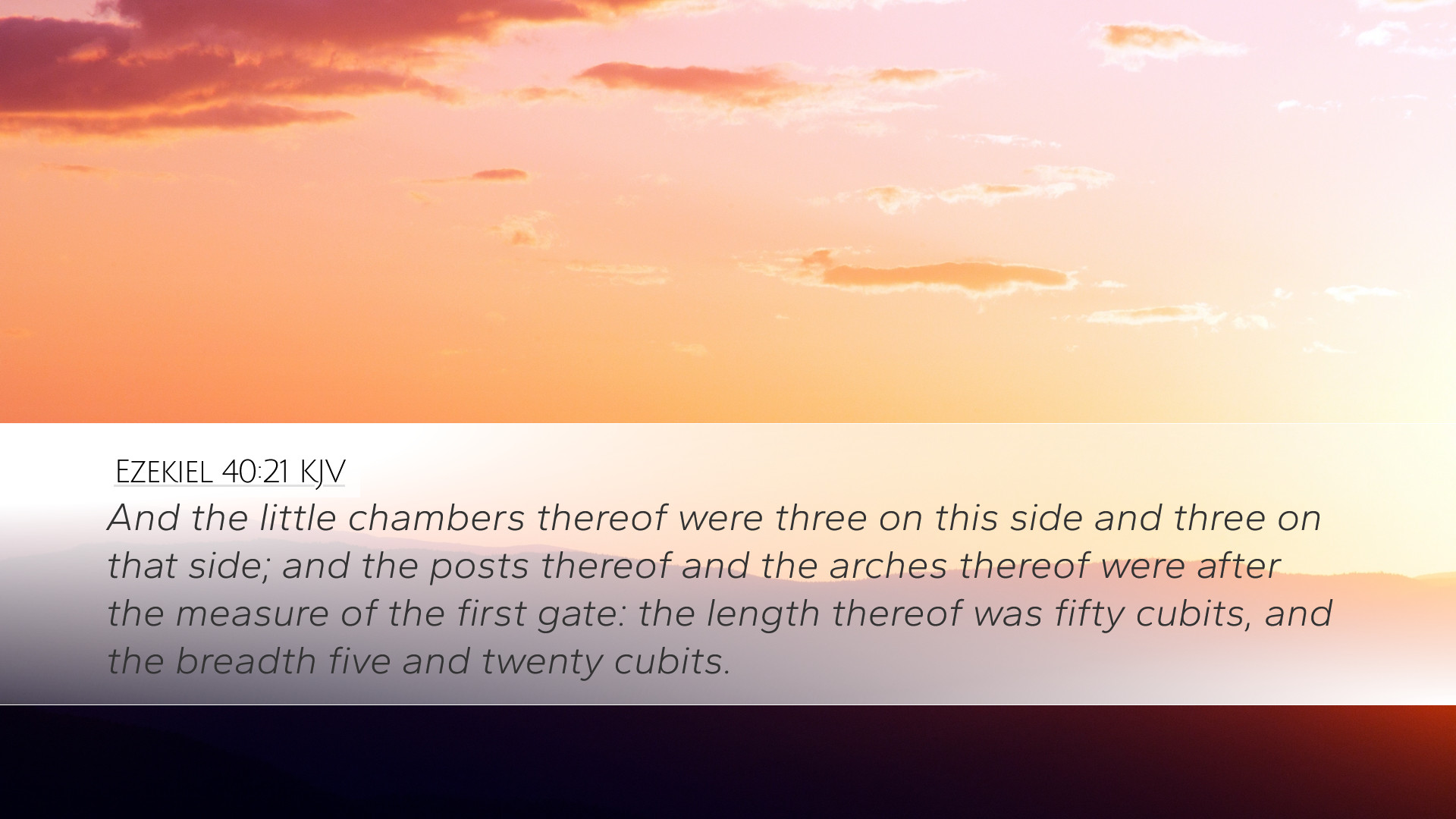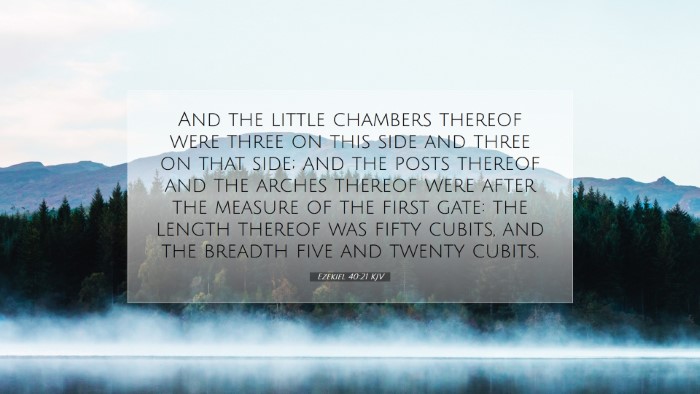Ezekiel 40:21 - A Comprehensive Commentary
Bible Verse: "And the little chambers thereof were three on this side, and three on that side: they had a porch of the house, and the pillars thereof were like the pillars of the chambers: the length of it was fifty cubits, and the breadth twenty-five cubits." - Ezekiel 40:21 (KJV)
Introduction
The vision of the rebuilt Temple is a pivotal theme in the book of Ezekiel. Ezekiel 40 marks the beginning of a detailed description of the Temple and the worship that is to take place within it. This verse specifically focuses on the structure and organization of the chambers associated with the Temple, emphasizing the divine order and design that governs the worship of God.
Contextual Overview
This passage is found within a broader prophetic vision where God instructs Ezekiel to measure the new Temple, symbolizing restoration and a renewed relationship between God and His people after the Babylonian exile. The specificity of the measurements and designs indicates that the Temple is not merely a physical space but a symbol of God's dwelling among His people.
Insights from Commentators
Matthew Henry
Matthew Henry highlights the meticulous detail in Ezekiel's vision, noting that the dimensions and arrangements of the chambers reflect God's order and holiness. He emphasizes that the three chambers on each side signify completeness, representing the fullness of God’s provision and truth. Moreover, the architectural elements, such as the porch and pillars, symbolize strength and stability, reinforcing the idea that the Temple is both a refuge and a place of divine encounter.
Albert Barnes
Albert Barnes provides significant insight regarding the construction aspects of the chambers mentioned in this verse. He notes that the "little chambers" serve multiple purposes, potentially for storage or for the priests who minister in the Temple. Barnes indicates that the porch enhances the grandeur of the entrance, while the description of pillars connects to wider biblical themes of support and the divine presence. He elaborates that this design reflects not just physical beauty but spiritual meaning—a place where God’s people can meet with Him majestically yet intimately.
Adam Clarke
Adam Clarke discusses the symbolism inherent in the measurements provided. He points out that the sizes—fifty cubits in length and twenty-five in breadth—may signify the vastness of God's glory and the sufficient space provided for worship. Clarke interprets the "porch of the house" as an important threshold leading into God’s presence, emphasizing the need for reverence and preparation before entering into communion with the Almighty. The architectural features become metaphors for the grace of God inviting His people into a deeper fellowship.
Theological Implications
The description of these chambers has significant theological implications:
- Divine Order: The structured design showcases God’s desire for order in worship. As the Israelites prepare to rebuild their lives after exile, the ordered space serves as a reminder that God is a God of structure and intent.
- Presence of God: The chambers represent the multifaceted nature of God’s presence among His people. Each chamber can be seen as an invitation to experience God in varying degrees of intimacy, accessibility, and depth.
- Restoration: This vision assures the exiled Israelites that God has not abandoned them; He is providing a means of restoration where their worship can be renewed in truth and spirit.
Practical Applications for Pastors and Theologians
From ezekiel 40:21, pastors, students, and theologians can derive several practical applications:
- Understanding Divine Architecture: Leaders should reflect on the significance of space in worship—a physical layout that encourages community, edification, and spiritual growth.
- Emphasizing Reverence: The design elements in worship spaces should foster a sense of reverence and preparation among congregants, reminiscent of the Temple's design that requires entering into God’s presence with awe.
- Teaching on Restoration: Pastors can use these insights to teach on how God desires to restore individuals and communities, underscoring that every believer has a place in His divine order.
Conclusion
In summary, Ezekiel 40:21 provides a rich tapestry of meaning that reveals God's intention for worship—highlighting His order, presence, and the hope of restoration. The commentaries of Henry, Barnes, and Clarke converge on the importance of both the physical and spiritual dimensions of worship, reminding readers that God's meticulous design serves to enhance our understanding of His relationship with us. As we delve deeper into this passage, we recognize the call to live lives that reflect this divine order and to engage with God in both reverence and intimacy.


